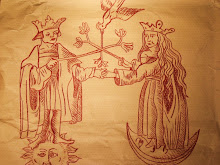Bread and Puppet incorporates 'Cantastoria' into its theatrical vision, mainly by putting on several different short Cantastorias prior to the weekly circus performances at the farm, thereby 'luring' visitors from their cars over to the circus field and broadening the framework of the whole circus experience.
During the internship I had the opportunity to develop a particular idea that has been burning away for some time (see previous post: The Moon, her Face changeth like the Sea) and to create a large-scale painting with moving elements. Little did I know earlier in London that my ideas about rotating discs behind 'windows' in a painting would link up to the Cantastoria tradition a few months later...
In Bread and Puppet's divine workshop I found an enourmous flattened cardboard box and set to work, making it into an upright screen with supporting 'wings'. I drew a simple design on it - a man in a boat, on the ocean - and then spent a significant amount of time cutting out boat, sail, waves etc from extra cardboard and layering it onto the board using masking tape and a long thumb nail to create crisp edges. It didn't look much at this stage but somehow I had a hunch that it'd be quite impressive when I got out the emulsion paint...

before...

...and after. It's amazing what cardboard, masking tape and a stanley knife can do.
In the paint storeroom I found some watered down dark blue paint, some more white and some black, and a couple of fairly stubby brushes. This is where the obsessive perfectionist in me winced...I have come to dislike runny paints, favouring the sharp clear detail made possible by thick acrylic paint and a teeny paintbrush. But forced to work with the limitations of my materials I made a wonderful discovery. Applying this watery paint to the board in layers with an old rag, and 'buffing' it into the surface, turned this cardboard surface into something resembling antique leather, the layers of translucent paint seemingly glowing on the surface. If I say so myself it looked a little magical, and I know that had my usual acrylic paint collection been available the surface of this board would have been dull and dead.

Next I painted the three discs to be fixed behind the board.

So now I had a painting with a moon which waxed from a new moon into a full moon, a shooting star which could flash by at any point, and a variety of different fishes which could swim by beneath the boat...
I 'performed' my board at the Bread and Puppet cabaret night, the 'Cafe des Cheap Artistes', and in Bread and Puppet style developed the actual performance a few hours beforehand. What brought it to life were: torches, held by audience members; a chord sequence played repeatedly on an old broken audioharp accompanied by sung notes (intended effect: eerie); a 'pattern' for the sequence of moving images, ie. the moon waxed, then the fishes changed, then a shooting star, then the moon waxed further...; bells jangled by audience members whenever they saw the shooting star...
I was very pleased with the performance but it left me with a clear sense of which areas need further investigation - namely, lighting (the possibilities of using solely candlelight or oil lamp, as was the traditional method of Cantastoria illumination)and how to create a 'painting-based' performance that can really take people on the journey, because happy as I was with my show it just about lasted five minutes! The odyssey continues on this one....


No comments:
Post a Comment